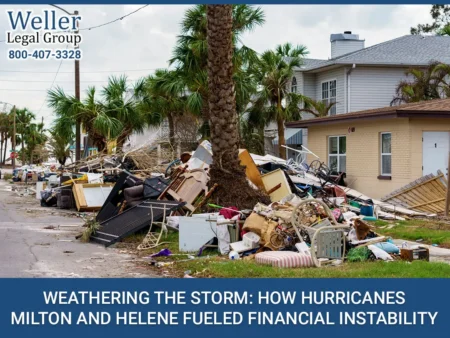
Recently, the Tampa Bay region has experienced a notable increase in personal and business bankruptcy filings. While many factors contribute to financial distress, natural disasters such as Hurricanes Milton and Helene have played a significant role in pushing already strained households and small businesses past the point of recovery. For those who found themselves unable to keep up with mounting debts in the aftermath, seeking the guidance of a knowledgeable bankruptcy attorney has become a necessary step toward regaining stability.
Understanding how weather events contribute to financial disruption helps shed light on why bankruptcy filings tend to rise in the wake of large-scale disasters.
Storm damage goes beyond property loss
Physical devastation is the most apparent effect of any hurricane. Strong winds, flooding, and power outages cause damage to homes, destroy inventory, and delay services. The effects of hurricanes go well beyond insurance claims and repairs. Families that are displaced frequently have to pay for temporary housing, lose their jobs, and borrow more money to cover their basic expenses. Long wait times for claim settlements can affect even insured people, creating a temporary liquidity crisis.
Hurricanes can stop operations for small business owners, particularly those in the retail, hospitality, or service sectors. Spoiled goods, damaged storefronts, and decreased customer activity cause weeks or months of lost revenue. While some companies can survive, others are compelled to use high-interest credit or postpone loan payments, both of which can result in insolvency if recovery is sluggish.
Job loss and income instability compound the issue
The job market itself is frequently disrupted in addition to property loss. Hourly or seasonal workers are particularly at risk because storms like Milton and Helene caused many restaurants, construction sites, and tourism-related businesses to close. People who were barely making ends meet ended up without any money during a period when costs were rising.
As employers work to recover, even salaried employees may face short-term layoffs or reduced hours. Many families are now unable to pay for things like rent, auto payments, or credit card balances because of this abrupt shift in their financial situation. What begins as a short-term setback may eventually turn into long-term economic instability.
Federal aid offers support, but is not a complete solution
Even though state and federal disaster assistance programs provide some assistance, they frequently don’t cover all losses. The scope of grants is usually restricted, and government loans increase the burden of preexisting debt. Families often receive aid months after the storm, by which point their debts have risen.
Moreover, it’s not always straightforward to apply for aid. Many storm victims struggle to complete the necessary paperwork, tests, and eligibility checks. So even those who qualify for help may get it too late to avoid falling behind.
Bankruptcy as a path to long-term recovery
After a natural disaster, filing for bankruptcy may be a sensible and legal way for people who are overburdened by debt to get back on their feet. Individuals and families can regain their financial stability by filing for Chapter 7 or Chapter 13 bankruptcy, which offers a structured way to discharge or reorganize debt.
For individuals facing financial difficulties due to bankruptcy, it is often viewed as a final option; it can offer a fresh start. This is particularly true when economic issues stem from circumstances beyond their control, rather than from a failure to apply the law sensibly and with the assistance of an accomplished lawyer.
A lasting financial aftershock
The Tampa Bay area continues to feel the effects of Hurricanes Milton and Helene. These storms have caused a series of financial difficulties, ranging from property loss to small business failure, prompting many locals to consider bankruptcy as a remedy. The rise in filings in the months after these incidents shows how severely these natural disasters can affect people’s financial well-being on both a personal and professional level.
Suppose you or someone you know is struggling with overwhelming debt due to hurricane-related losses. In that case, it may be time to speak with a qualified bankruptcy attorney who understands the challenges facing residents of Tampa Bay. Weller Legal Group has been serving the community with compassion and professionalism, helping clients navigate a clear path toward financial recovery.
Picture Credit: Depositphotos


